Motivation and objectives
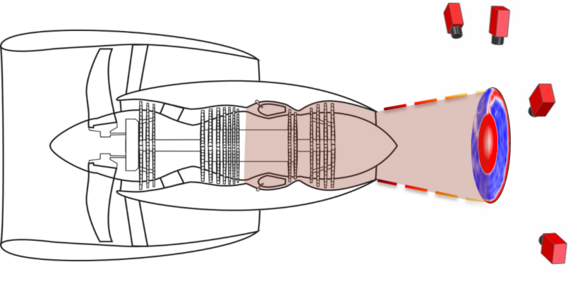
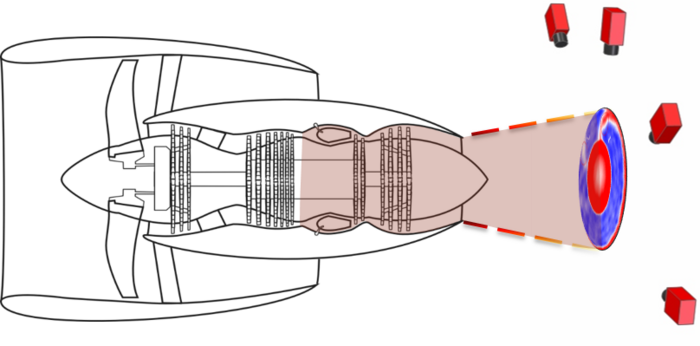
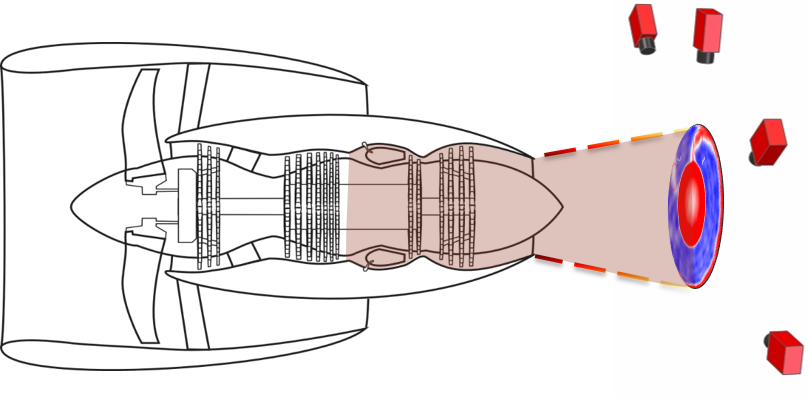
Motivation and objectives
Currently, aircraft engines have to be first dismounted before defective parts can be identified. The complexity and duration of repairs and therefore the downtime of the engine currently cannot be accurately estimated, because the existing defects can be found only during ongoing regeneration process. Consequently, the regeneration process is not only time- and cost-intensive, but also has serious uncertainties in the planning. The methodology, which is being developed in the subproject A3, allows to evaluate the condition of an aircraft engine without its dismounting. The idea of the methodology is that defective parts in the hot gas path (HGP, engine components after combustion chamber) have an influence on the local density distribution in the flow in form of density irregularities that extend throughout the HGP up to the exhaust jet. The irregularities in the exhaust jet can be detected with the help of the Background-Oriented Schlieren method that allows to identify, which engine defect was the cause of it. It therefore allows both a quick check of the engines for faulty parts and appropriate maintenance, and improved planning of repair procedures due to early damage identification.
Results
In the first two funding periods of the SFB it was possible to show numerically that defective parts have an influence on the density distribution in the exhaust jet, and that they can be detected by tomographic BOS measurements. With the help of pattern recognition algorithms is was also possible to analyze the reconstructed density distributions and automatically identify the defects. Alongside with these numerical investigations, it was shown at the helicopter engine of TFD that the application of the tomographic BOS measurements on engines is generally possible. Moreover, tomographic BOS measurements at the model of a combustion chamber showed that it is also possible to detect the defects in combustion chambers with the help of density distributions in the exhaust jet. Even small deviations of the burner performance of a circular combustion chamber could be detected via further development of the tomographic analysis algorithms.
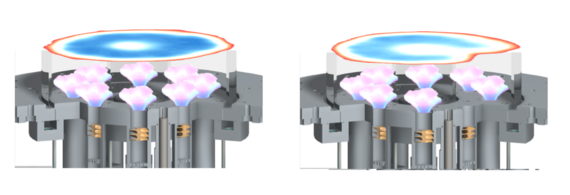
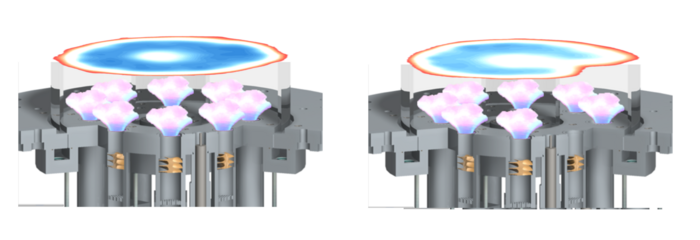
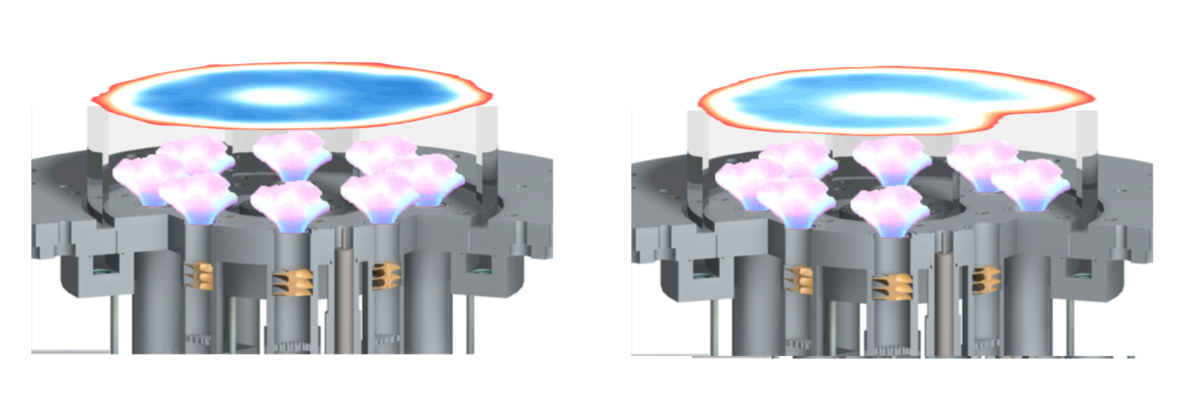
Density distribution in the exhaust jet of a swirl burner array for the reference case (left) and a complete shutdown of one burner (right).
Current research and outlook
Finally, the developed methodology should be validated at the real aircraft engine during the current third funding period of the SFB. To this end, predefined defects will be applied to the engine and the exhaust jet will be reconstructed with the tomographic BOS method during two measurement campaigns. The influence of the defects on the exhaust jet will be investigated by a comparison of the measurements with a reference state of the engine (without defects). Additionally, this influence will be estimated in a numerical model that will be validated with the help of measurement results. After this validation, it is possible to predict numerically the influence of other defects on the exhaust jet and to build a data bank with different damage cases. An engine in an unknown state can be then optically measured and the measurement results with the help of pattern recognition algorithms can be compared with the data bank. Therefore, the defects can be detected contact-free without the dismounting of the engine.
Subproject leader
30823 Garbsen
30823 Garbsen
Staff
Publications
International Scientific Journal Paper, peer-reviewed
-
(2020): Influence of combined compressor and turbine deterioration on the overall performance of a jet engine using RANS simulation and Pseudo Bond Graph approach, J. Glob. Power Propuls. Soc. 4 (3), S. 296–308
DOI: 10.33737/jgpps/131109 -
(2016): Combining ART and FBP for improved fidelity of tomographic BOS, Meas. Sci. Technol. 27 (9), S. 097001
DOI: 10.1088/0957-0233/27/9/097001 -
(2016): Automatic Detection of Defects in a Swirl Burner Array Through an Exhaust Jet Pattern Analysis, In: J. Eng. Gas Turbines Power 139 (3)
DOI: 10.1115/1.4034449 -
(2014): Methodology for evaluating hot gas path defects in an exhaust jet, Aerospace Science and Technology 39 (Vol. 39), S. 120–127
DOI: 10.1016/j.ast.2014.08.011 -
(2012): Time Resolved Full-Annulus Computations of a Turbine with Inhomogeneous Inlet Conditions, International Journal of Gas Turbine, Propulsion and Power Systems 4,2, S. 01–07
International Conference Paper, peer-reviewed
-
(2018): Automated Condition Evaluation of Hot-Gas Path Components of Jet Engines through Exhaust Jet Analysis, Proceedings of the ASME Turbo Expo 2018, 11-15 June 2018, Oslo, Norway, GT2018-75384
-
(2016): Numerical Evaluation of the Condition of a Jet Engine through Exhaust Jet Analysis, In: ASME (Hg.): Proceedings of the ASME Turbo Expo 2016
-
(2016): Automatic Detection of Defects in an Annular Swirl Burner Array Through an Exhaust Jet Pattern Analysis, Proceedings of the ASME Turbo Expo 2016, S. 1–10
-
(2016): Early Defect Detection on an annular Swirl-Burner-Array by Optical Measuring Exhaust Gases and Numerical Analysis, In: Proceedings of the ASME Turbo Expo 2016, June 13-17, 2016, Seoul, South Korea
-
(2015): Application of an Algebraic Reconstruction Algorithm to Tomographic BOS Measurements, In: Gas Turbine Society of Japan (Hg.): Proceedings of International Gas Turbine Congress 2015, Japan, S. 1214–1221
-
(2013): Impact of Defects and Damage in Aircraft Engines on the Exhaust Jet, Proceedings of the ASME Turbo Expo, 3-7 June 2013, San Antonio, USA, GT2013-95709
-
(2013): Experimental Demonstration of Analyzing an Engine's Exhaust Jet with the Background-Oriented Schlieren Method, AIAA Ground Testing Conference, 24-27 June 2013, San Diego, USA
-
(2013): Early Assessment of Defects and Damage in Jet Engines, International Through-Life Engineering Services Conference, Bd. 11. Cranfield, England, S. 328–333
DOI: 10.1016/j.procir.2013.07.022 -
(2011): Time Resolved Full-Annulus Computations of a Turbine with Inhomogeneous Inlet Conditions, International Gas Turbine Congress 2011 Osaka, Japan, IGTC2011-0175
International Conference Paper, not peer-reviewed
-
(2018): Experimental Defect Detection in a Swirl-Burner Array Through Exhaust Jet Analysis, 2018 AIAA Aerospace Sciences Meeting, AIAA SciTech Forum, 8-12 January 2018, Kissimmee, Florida, USA, AIAA2018-0303
DOI: 10.2514/6.2018-0303 -
(2015): Tomographic Background Oriented Schlieren Applications for Turbomachinery , 53rd AIAA Aerospace Sciences Meeting (invited), 5-9 January 2015, Kissimmee, Florida
DOI: 10.2514/6.2015-1690 -
(2014): Application of the Background-Oriented Schlieren Method for the Analysis of an Engine's Exhaust Jet, XXII Biannual Symposium on Measuring Techniques in Turbomachinery, 4-5 September 2014, Lyon, France
-
(2011): Inverse Methods in Turbomachinery Applications, Aachen Conference on Computational Engineering Science (ACCES). Aachen, 01.01.2011
National Conference Paper, not peer-reviewed
-
(2015): Fehlerfrüherkennung von Brennkammerdefekten einer Ringbrennkammer aus einem 8-Drallbrenner-Array mittels optischer Abgasstrahlanalyse und numerischer Zuordnung, 27. Deutscher Flammentag Verbrennung und Feuerung, Düsseldorf: VDI-Verlag, S. 393–402
-
(2015): Correlation of Defects in an Annular Swirl-Burner-Array by Optical Measuring Exhaust Gases and Numerical Analysis, 64. Deutscher Luft- und Raumfahrtkongress 2015, 22-24 September 2015, Rostock
Dissertationen
-
(2014): Zustandsbeurteilung eines Triebwerks durch die Analyse des Abgasstrahls, Leibniz Universität Hannover, Berichte aus Institut für Turbomaschinen und Fluid-Dynamik Band 6/2014




